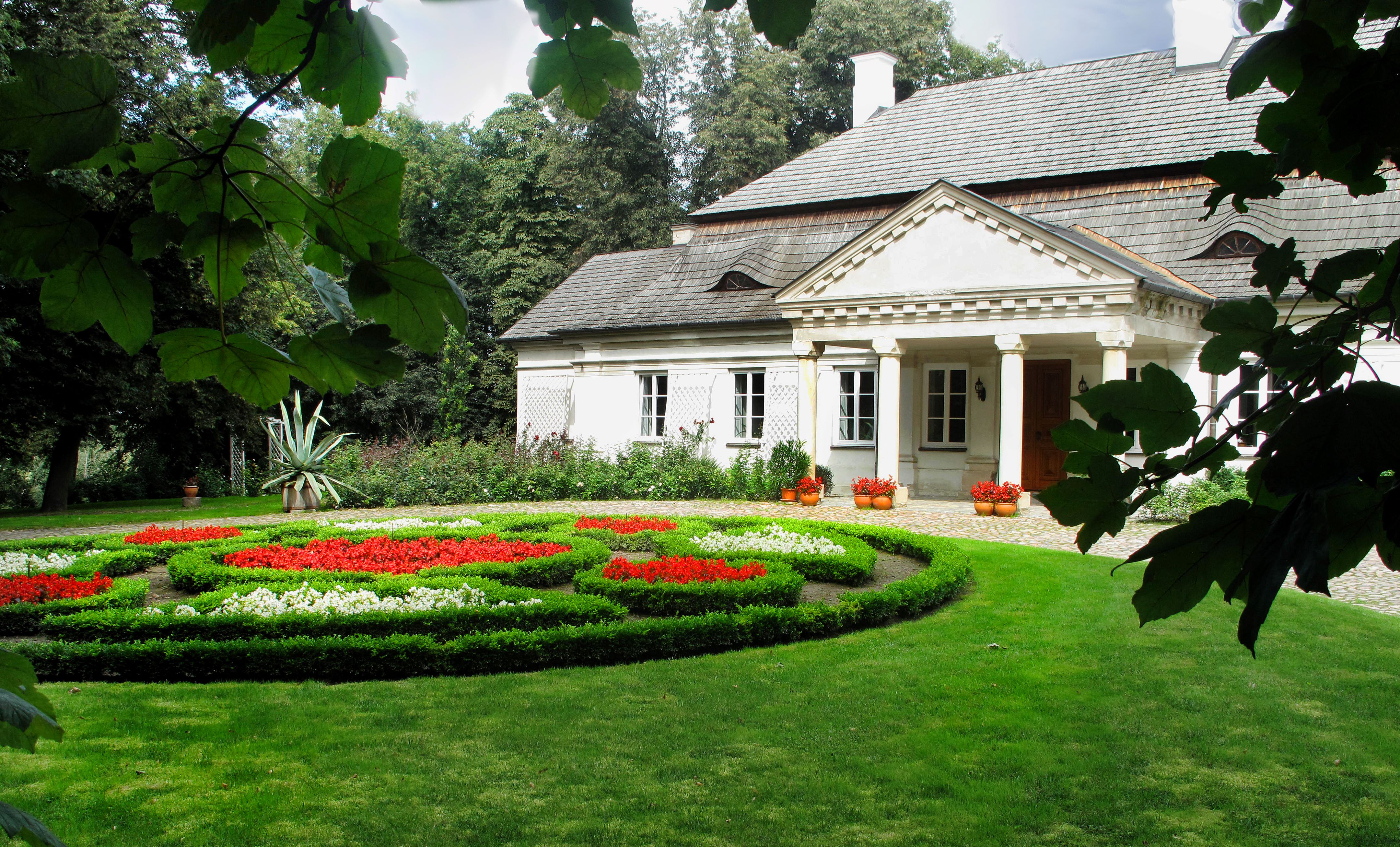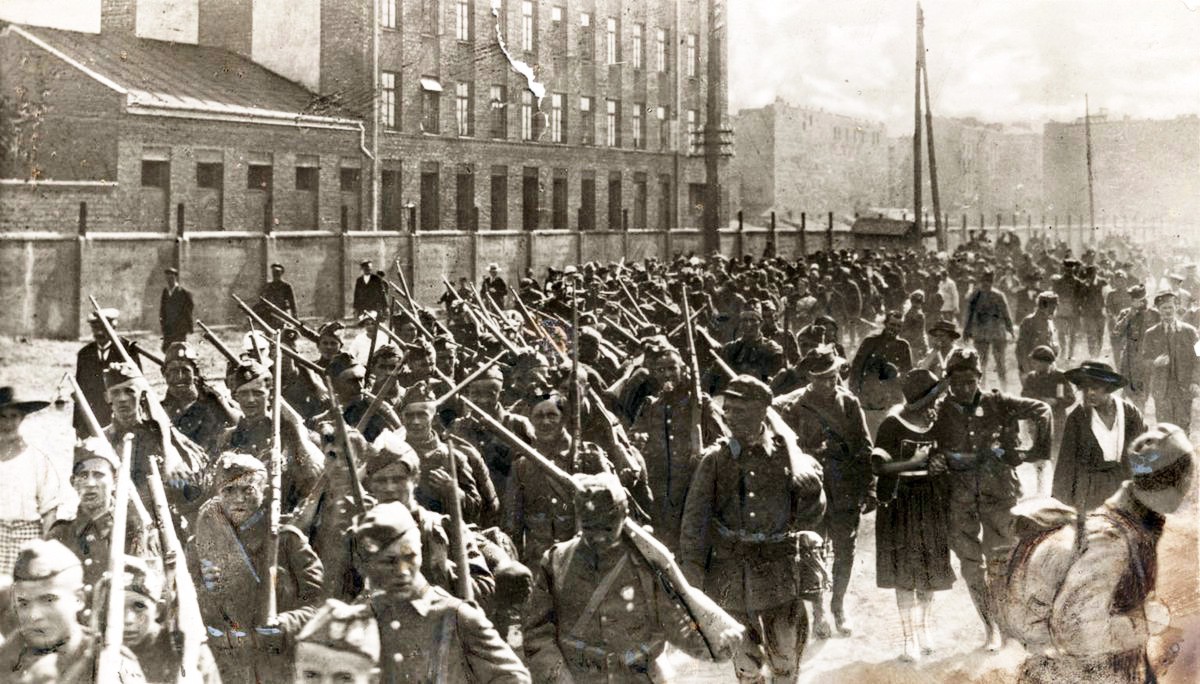“I am the Polish manor house, which fights bravely and loyally stands on guard,” was written above the entrance to a manor in Pęcice in the Masovian region. This short sentence, like no other, seems to contain the key to the importance of the manors of the Polish noble and landed gentry.
To begin with, as a theme for our conversation, I propose a statement made by my friend, Michael Thomas (1933-2010), a professor at many British universities, a man familiar with the history of Polish manors as a result of our 30 year cooperation:
“Any visitor to Poland should be aware of the hidden treasures scattered all over the Polish countryside. “Dwór”, the Polish manor house, is a unique repository of Polish social and cultural history, and in terms of the past, their existence and extent are unique in all of Europe.”
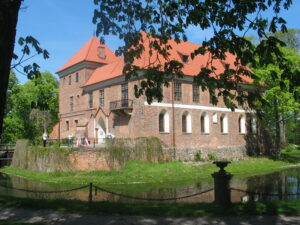
A measure of a nation’s identity is the specificity of its culture and history. And in Poland was mainly created by the nobility and landed gentry. Thus, manor houses – landowners’ seats – are a characteristic feature of the Polish landscape.
What exactly are manor houses?
They are what we would call the one-story residences of landowners, i.e. buildings smaller than castles and palaces, yet larger than peasant cottages. They were built first as defensive knights’ seats, and later as residences. Manor houses were always a place for the cultivation of family traditions, noble culture, customs and the fight for the Polish identity.
For the landed gentry, these estates were not just a farm to sustain and provide for themselves. Although they were focused on agricultural production, the manor house was also a family home, in many cases an ancestral seat held for many generations, and an enduring hub of independence from the invaders in the 19th century. It should be remembered, that in the times when Poland was under the Prussian, Austrian and Russian partitions, it was the landed gentry’s manor houses that cultivated cultural traditions and ensured that Poles were not deprived of their national identity.
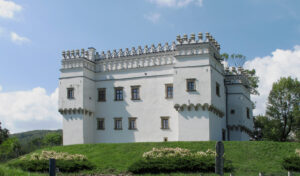
The manor house was the center of the village. Apart from their own seat, the landowners also built houses and schools for subordinate peasants. The manors were also a specific first aid point for the villagers. Additionally, due to the landowners’ strong ties to the Catholic religion, they built churches in their villages, and helped ensure that Catholic Christmas rites were cultivated.
Manors were not only a family nest and a symbol of the duration and strength of Polish tradition, there were also valuable repositories of historical artefacts and objects, works of art and libraries in almost every house. Outstanding Poles were born in the manor houses:
- Military leaders: Tadeusz Kościuszko (Mereczowszczyzna, today’s Brest region), Kazimierz Pułaski (Warka, central Poland), Józef Wybicki (Będomin, northern Poland), Józef Piłsudski (Zułów, today’s Lithuania);
- Composers: Fryderyk Chopin (Żelazowa Wola, central Poland), Stanisław Moniuszko (Ubiel, near Minsk), Karol Szymanowski (Tymoszówka, today’s Ukraine), Ignacy Paderewski (Kuryłówka, south-eastern Poland, today’s Ukraine);
- Writers: Adam Mickiewicz (Zaosie, today’s Belarus), Cyprian Kamil Norwid (Głuchy, central Poland), Henryk Sienkiewicz (Wola Okrzejska, eastern Poland), Czesław Miłosz (Szetejny, today’s Lithuania),
- Painters: Piotr Michałowski, Włodzimierz Tetmajer, Józef Brandt and many others.
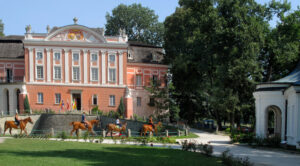
In medieval times, the seats of families performed defensive functions. It was only in the early modern period that the purpose and location of these seats changed.
Until the mid-17th century, manors were built as fortified knights’ seats because safety was a priority. The manor house was not a single building, but an entire defensive complex. In the 14th or 15th century, a knight would build his house of wood on a stone foundation, taking care to place it on a hill. He would choose a place large enough to accommodate several buildings. It would be surrounded by a wooden palisade and a ditch, and, since the best places were near a river or even a stream or lake, the ditch became a moat. In this way, a defensive bypass inside the moat was created, which was also called the fortress. This location did not change that much in the following centuries. The elevated location and close proximity to rivers and lakes is characteristic of Polish manors and palaces.
Some of the larger brick buildings of this type are called castles. The smaller ones – fortified manors. And there aren’t many of them left. We can see the most beautiful in Oporów near Kutno (photo 1), Dębno in the Małopolska region (both now house museums), and the oldest of them from the end of the 14th and the beginning of the 15th centuries – in Wieruszyce near Bochnia. Unfortunately, not a single example of a wooden defensive manor has survived.
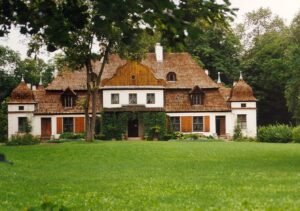
Architects created them, as it was said, “according to heaven and Polish custom”. What does this mean exactly?
“Rightly, then, a separate ‘architectura civilis’ is to serve for every nation, also for Poland. Because whoever wants to have a foreign residence must live as a foreigner. And since it is difficult to change life, as the old custom has already stated, thus one needs to adapt a house and a living to it”. This is what Łukasz Opaliński wrote in 1659, in a book published in Krakow entitled: A short study on how to build mansions, palaces, castles according to heaven and Polish custom. This book became a benchmark for the nobility building their residencies. From the second half of the 17th century, manors – seats characteristic of the Polish landscape and Polish identity – were built. But the history of Polish manors, as I said before, goes back to the Middle Ages.
Over the centuries, the architecture of the manors changed according to the needs of the owner. In order to lay out the shape and architectural structure of the Polish manor house throughout the centuries, I propose a slightly simplified outline. The oldest mansions that have survived to our times come from the Gothic period in the 15th century. At the end of the 16th and at the beginning of the 17th centuries – we have Renaissance manors (photo 2). Both of these types of manor houses were to play primarily defensive functions. Eventually, in accordance with Opaliński’s recommendations, the manor evolved into a residence, not a fortress. Opaliński wrote: “A good building must fulfill three conditions: first power and thorough durability, comfort, finally shape and beautiful appearance…” In the 17th century people began to pay attention to the comfort and aesthetic of their houses.
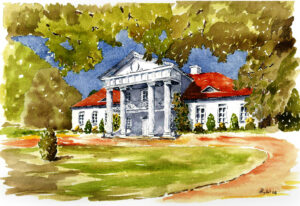
The vast majority of landowners’ seats that have survived to our times come from the 18th and 19th centuries and had served their owners for generations. As necessary, and in line with changing fashion, these seats had been expanded and modernized. (photo 3)
How did Polish noble residences stand out from other European residences?
It is characteristic of Poland that there were relatively many such small landowners’ seats compared to other European countries. In 18th century Poland, the percentage of nobility in the society was relatively the highest (around 10%) compared to other European countries (around 3-4%). Each landowner tried to distinguish a prestigious seat that would highlight their social position. The petite nobleman wanted a prestigious residence, but could not afford a multi-story palace. So he would build a reduced version of it. A very characteristic feature of the architecture of the Polish manor house, especially in the Baroque era, were the archers (pol. alkierz), i.e. corner extensions, which were miniature versions of defensive towers (photo 4). Also characteristic for Polish manors are high roofs, a hipped or a gambrel roof, with parallel slopes, top and bottom (photo 8). These are quite different from French mansard roofs. (photo 7)
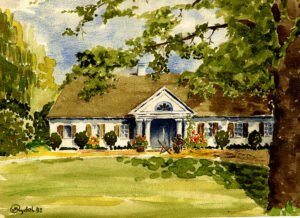
When Poles themselves think of the Polish manor, they see a one or two-story house with columns. Is this a simplification?
Until the last decade of the 18th century, the manor’s artistic architectural expression was derived from the Baroque, later neoclassicism dominated their architecture. The most popular mansions today, which every Pole associate with a “typical Polish manor”, are those with a two- or four-column portico on the axis of the front elevation. To mark the social status of a landowner, porticoes were sometimes built in the so-called giant architectural order. This means that the columns extend higher than the eaves. An example is the manor in Żytno (photo 5). There were many such mansions especially in the eastern borderlands of Poland. A classic Polish manor house is situated on a hill, always surrounded by a park, has one-story and preferably a hipped roof. In the eastern part of Poland, back in the 18th century, manors were made of a larch logging framework covered with wooden shingles. In western and northern Poland, brick mansions covered with tiles were dominant. The manor house should be oriented “at eleven o’clock” so that the sun illuminates all four facades, it is to face the road (not sideways). An avenue should lead to the manor house, and a small lawn in front of the manor house should form the courtyard of honor (cour d ‘honneur). Such an image of the manor house is dear to every Pole, and most surviving manors are of this type. (photo 6)
It is also known that other social classes also wanted to model their homes on the manors.
In the 19th century, when not only people of noble origin became the owners of estates, lands were bought by townspeople, industrialists and foreigners and they built palaces and manors modeled on traditional landowners’ seats. Some of them also became landowners themselves. Such buildings also appeared in cities. Presbyteries resembling manors were built next to churches, and after the mid-19th century, even railway stations reflected this style. In the early 20th century, the so-called manor or national house style appeared, with the obligatory columned portico at the front. It was a conscious reference to the classic, symmetrical shapes of Polish mansions, and this architecture, apart from landowners’ seats, became common in cities and towns. (photo 7, 8)
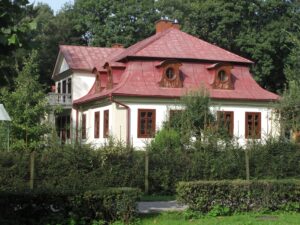
The Polish manor house not only has charm, but is also rich in custom, ritual and adherence to tradition. This is probably a topic for a separate story, but are we able to define the influence of the manor on Polish culture?
The greatest works of art come from the landowner culture. The collections in leading Polish museums come largely from private collections. The Czartoryski Museum in Puławy, founded in the early 19th century, is still in Krakow, the Ossoliński National Institute, “Ossolineum”, first established in Lwów, and today in Wrocław, is enriched with the Museum of the Princes Lubomirski. Moreover, museums in Łańcut with the collections of the Potocki family, or in Rogalin with the collections of the Raczyński family – these are just some of the great cultural assets, the legacy of aristocratic families.
On the other hand, the landowners’ culture was created mainly by the habits of moderately wealthy landowners. The specificity of the landowner’s culture includes the appearance of the manor house and its surroundings, as well as its interior. Full of family mementoes, [the manors hold]: portraits of ancestors on the walls, family trees, family albums, souvenirs of participation in battles and uprisings, and an overall abundance of Polish history. In some mansions there were collections of works of art, weapons, porcelain or rich libraries. Almost every manor house was a kind of family museum. The landowners’ customs included hunting traditions as well as customs related to Catholic holidays. A separate group of landowners’ customs are cuisine, venison dishes, ways of preparing wonderful Polish dishes, alcoholic beverages: vodkas, beer, and liqueurs, as well as traditional costumes (kontusz). (photo 9)
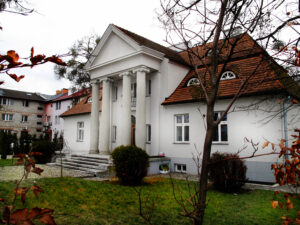
In the history of Poland, the family of a knight, nobleman and landowner was the foundation of traditional national and civic values. Passed down from generation to generation, they were a treasury of traditions and ethical obligations. The most important was a family of many generations and many children, perceived in a traditional way, in which the owner of the house was the head. It was very important to respect and care for the elders as well as to respect their orders. There was a canon of values based on the decalogue and patriotism, honor, readiness to sacrifice oneself for the cause of the country, worship of ancestors and national traditions. The specific landowner code provided for, among others: courage and strength in fighting enemies and life’s adversities. They were defenders of the homeland, family, fatherhood, the weaker and the disadvantaged, or those affected by fate. Also fair play and respect for the opponent. In addition: Responsibility for words and deeds, keeping a given word (oath), caring for the good name of the family and honor, adherence to the Catholic religion, defending faith, as well as tolerance, and respecting non-believers. The specific landowners’ tradition also provided for love of the land, fatherhood, hospitality, and attachment to culture.
The Second World War and the period of communism brought about the destruction of Polish manors. Can we say how many such residences existed in Poland before the Second World War, and how many have survived to the present day? In what shape are they now?
In the interwar period, the number of people of landowners’ origin amounted to 0.7% of the entire country’s population, i.e. around 250,000. There were about 20,000 manors, palaces and castles in 1939, including one-story mansions about 16,000. Some landowners had several or a dozen estates. It must be remembered that we are talking about Poland within its pre-war borders, and therefore including the Eastern Borderlands.
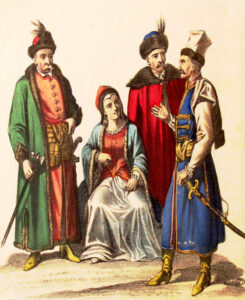
After the crimes of the extermination of the gentry in 1939-1956, after the change of borders, the number of descendants of landowners (as broadly understood and not only landowners) living in Poland at the beginning of the 21st century can be estimated at approx. 35-40,000, i.e. around 15 percent of the number landowners in 1939. About 10,000 descendants of landowners live abroad, as children and grandchildren of emigrants “to the west”, exiles “to the east”, Eastern Borderlanders living in the former territories of the Second Polish Republic, and finally people who were displaced abroad or escaped from communist-ruled Poland after 1945.
Out of 16,000 single-story mansions existing until 1939, about 3,000 retained at least the external character of its architecture till XXI century. From the point of view of their condition, approx. 2,000 are in a state of advanced devastation, or only the outer walls remain. They most often belong to state or local government institutions. Many of them are empty. To this day, there is no re-privatization act in Poland and the communist decrees of 1944-46 which expropriated landowners are still in force.
There are about 150 mansions that have survived and continue the traditions of the Polish gentry within the country’s present borders, including museums, which is 1 percent of their total from before 1939. In what was formerly known as eastern Poland, which today belongs to Ukraine, Belarus and Lithuania, there are much fewer manors, and those that continue the traditions of the Polish gentry can be counted on the fingers of one hand. (photo 10)
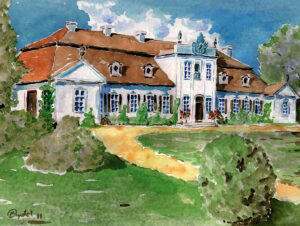
About a thousand mansions in Poland are currently schools, rural health centers or apartments of random tenants. Their condition is usually bad. In a few cases, the historic elements of the interior have survived: stoves, fireplaces, woodwork.
Of the above-mentioned 150 manors: 30 belong to the descendants of their former owners, from before the Second World War. These are the smallest buildings that were not the center of farming, i.e. summer houses. Another 30 were bought from the state by the descendants who live there now. There are museums of manor interiors and biographical museums in almost 60 other manors. Out of about 400 manors that were bought in the last 30 years by private individuals who were not the descendants of the owners, only about 20 can be considered as showing the traditions of the Polish manor. (photo 11)
About 350 manor houses are guesthouses, hotels, restaurants and conference centers, owned by companies or private persons. Only a few of them preserve the atmosphere of a Polish manor.
The situation of larger buildings – palaces – is a bit better. Several dozen of them are state or local government museums. After 1990, a few were returned to their rightful owners. The rest are waiting for a re-privatization act. Palaces play the role of offices for farms, schools, private apartments (usually with several families in one palace). Most of them, however, are devastated and empty.
After the fall of communism, societies and associations were established in order to promote memory and traditions related to the Polish manor.
In 1990, the Polish Landowners’ Association was established as a continuation of the Union of Landowners operating in the pre-war period. After years of persecution, when the landowners, deprived of their property and family seats, gained the opportunity to associate, the Polish Landowners’ Association includes the descendants of their former landowners and their families. The Polish Landowners’ Association, with headquarter in Warsaw, has 11 field offices in other cities in Poland and cooperates with Polish landowners’ unions in France and Great Britain. I am honored to be the vice-president of the Main Board of this association, and my tasks are to collect documentation on landowners’ seats and their owners, and to popularize the subject of landowners. It manifests itself in the form of books, articles in magazines, participation in conferences, organization of exhibitions, delivering lectures.
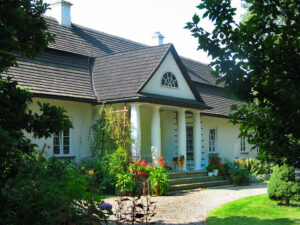
The main goals of the Association are: integrating the landowners’ milieu and carrying out activities aimed at continuing landowners’ traditions, promoting the cultural heritage of the landed gentry, contributing to the preservation of the national heritage in the form of manor and palace complexes and other material and non-material elements of the landed gentry’s past, supporting the education of landowners’ youth in the spirit of respect for national traditions, as well as the fight to regulate ownership relations and respect for property rights in Poland (re-privatization). The Polish Landowners’ Association fights for the dignity of Poland and Poles by annulling the Stalinist decrees of 1944 and later, suspending the sale of landowners’ properties and supporting returns to their family homes. It strives for an honest form of the re-privatization act. The expulsion of landowners, the annexation and the devastation of their estates is the most embarrassing fragment of Poland’s post-war history.
The Polish Landowners’ Association cooperates with the European Landowners Organization, which brings together landowners’ organizations from all over the United Europe. The seat of the association is in Brussels. The Polish Landowners’ Association cooperates with related organizations: the Association of the Polish Nobility, the Association of the Descendants of the Great Sejm (Parliament) and the “Domus Polonorum” Association.

Dr Maciej Rydel – Documentalist of Polish manors and the history of the gentry. Author of 5 books on that subject. Author of over 150 articles and lectures on the Polish gentry. Author of 20 photo exhibitions (including in Brussels, Jaszuny, Lithuania and participation in an exhibition in London). Painter-documentalist. Vice President of the Main Board of the Polish Landowners’ Association, Vice-president of the Gdańsk Branch of the Association of Art Historians. He was awarded the Knight’s Cross of the Order of Polonia Restituta (2014) for his contribution to the national heritage.
Interviewer: Piotr Abryszeński – PhD, employee of the History Research Office of Institute of National Remembrance
Translation: Alicja Rose & Jessica Sirotin
All photos and watercolours by Maciej Rydel. All rights reserved.

